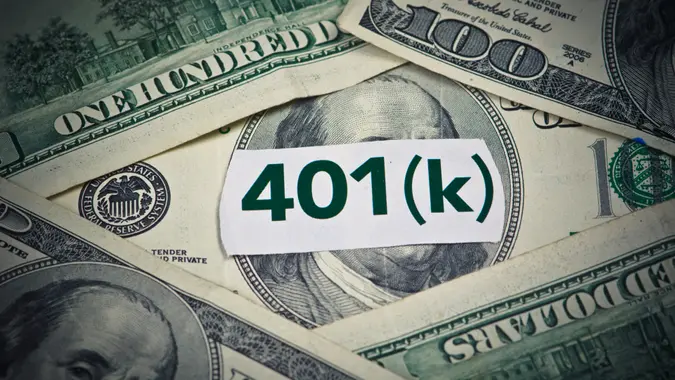Roth IRA Interest Rates: What You Really Earn in 2025

Commitment to Our Readers
GOBankingRates' editorial team is committed to bringing you unbiased reviews and information. We use data-driven methodologies to evaluate financial products and services - our reviews and ratings are not influenced by advertisers. You can read more about our editorial guidelines and our products and services review methodology.

20 Years
Helping You Live Richer

Reviewed
by Experts

Trusted by
Millions of Readers
If you’ve ever searched “Roth IRA interest rates,” you’re not alone — but here’s the truth: Roth IRAs don’t pay a set interest rate. Instead, your returns depend entirely on what you invest in, whether that’s stocks, bonds, CDs or mutual funds. The good news? Those investments can grow tax-free for decades, helping you build long-term wealth faster than a taxable account.
Let’s break down how Roth IRAs actually grow, what realistic 2025 returns look like and how to choose the best mix for your goals.
Do Roth IRAs Have Interest Rates?
If you’ve ever wondered whether your Roth IRA earns interest, you’re not alone. The short answer is no — at least not in the way a savings account does. Your Roth IRA doesn’t pay a fixed rate; instead, your returns depend on what you invest in.
Here’s what that really means and why the confusion exists.
A Roth IRA Is an Account — Not an Investment
A Roth IRA isn’t a product that pays interest — it’s a tax-advantaged retirement account designed to hold your investments. Inside, you can invest in:
- Stocks or ETFs for long-term growth
- Bonds and CDs for steady income
- Mutual funds for diversification
Your returns depend on what you buy, not the account itself.
2025 contribution limits: You can invest up to $7,000 in a Roth IRA this year, or $8,000 if you’re 50 or older.
Why People Confuse Roth IRAs With “Interest-Bearing” Accounts
If you hold CDs or savings products inside your Roth IRA, you’ll see interest earnings — but that interest comes from the underlying investment, not the IRA itself.
Think of your Roth IRA as a container:
So while there’s no fixed “Roth IRA rate,” your overall return might range anywhere from 4% to 10% annually, depending on your portfolio mix and risk tolerance.
2025 Roth IRA Returns: What You Can Expect
Here’s a snapshot of what different Roth IRA investments are earning in 2025.
| Investment Type | Typical 2025 Range | Risk Level | Notes |
|---|---|---|---|
| High-Yield Savings/IRA CDs | 4%-5% APY | Low | Top IRA CD rates average ~5.08%, according to the FDIC. |
| Bond Funds/Money Markets | 4%-5% yields | Moderate | Vanguard data shows bonds outperformed inflation in 71% of years since 1975. |
| U.S. Stock Index Funds | 7%-10% average annualized | High | The S&P 500 has returned ~10.5% annually long term (S&P Dow Jones Indices). |
| Balanced Mutual Funds/ETFs | 6%-8% | Moderate | Offers built-in diversification with smoother growth potential. |
Bottom line: Your Roth IRA performance depends entirely on your investments — not a preset interest rate.
How Compounding Builds Wealth in a Roth IRA
The biggest advantage of a Roth IRA is tax-free compounding. You don’t pay taxes on interest, dividends or capital gains while your money grows — and once you meet the IRS age (59½) and five-year rule, withdrawals are tax-free, too.
Let’s see how compounding plays out:
| Average Annual Return | Starting Balance | Value After 20 Years |
|---|---|---|
| 6% | $50,000 | $160,000 |
| 8% | $50,000 | $233,000 |
That’s an extra $73,000 in tax-free growth — just from a 2% higher average return.
Tip: Reinvest your dividends instead of taking them as cash. This helps your Roth IRA balance compound even faster.
Factors That Affect Roth IRA Growth
Not all Roth IRAs grow at the same pace. Your long-term results depend on several key factors — from how much you contribute to how aggressively you invest. Understanding these variables can help you make smarter decisions and keep your retirement savings on track.
1. Contribution Limits and Consistency
The more you contribute — and the longer you do it — the faster your money compounds.
If you max out contributions at $7,000 per year for 20 years and average an 8% return, you could accumulate nearly $344,000 in tax-free savings.
2. Investment Mix and Risk Tolerance
According to Vanguard, portfolios with 70% stocks and 30% bonds historically return about 9.2% per year, while all-bond portfolios average ~5%. Finding the right balance for your comfort level is key.
3. Time Horizon and Market Exposure
The longer your money stays invested, the more powerful compounding becomes. Someone with 25+ years until retirement can lean toward growth assets; someone five years out might shift more into CDs or bond funds.
4. Market Conditions vs. Fixed Yields
Markets fluctuate, but fixed-income products like CDs or Treasury bonds offer consistent returns. Many retirees use a mix for balance — stocks for growth and CDs for stability.
How To Maximize Roth IRA Returns
If you want your Roth IRA to grow faster, strategy matters. Diversifying your investments, rebalancing regularly and knowing when to adjust your risk level can all make a difference.
Here’s how to fine-tune your Roth IRA for stronger, steadier performance over time:
Diversify Your Investments
Spread your Roth IRA across multiple assets — stocks, bonds and CDs — to balance growth potential with safety.
Use the Roth for High-Growth Assets
Because Roth withdrawals are tax-free, placing your highest-growth investments inside helps you maximize long-term, after-tax returns.
Rebalance Regularly
Check your allocation once or twice a year to stay aligned with your goals and market conditions.
Adjust as You Near Retirement
Within five years of retiring, consider shifting toward lower-risk investments like CDs or short-term bond funds to preserve capital.
Pro Insight: Vanguard’s 2025 “How America Saves” report found that between 2020 and 2024, the average annual 401(k) return was 8%.
Final Take to GO: Roth IRAs Don’t Pay Interest — They Build Wealth
When people ask about Roth IRA interest rates, they’re really asking how much their investments can earn. In 2025, high-yield CDs may pay around 5%, while diversified stock portfolios have historically delivered 7% to 10% annual returns.
The key is simple:
- Choose investments that match your risk tolerance and goals.
- Contribute consistently.
- Let compounding do the heavy lifting.
Over time, your Roth IRA can become one of the most powerful, tax-free wealth-building tools in your retirement plan.
Next Step: Try the GoBankingRates Retirement Calculator to see how your Roth IRA contributions could grow over the next 10, 20 or 30 years.
FAQs
Here are the answers to some of the most frequently asked questions about Roth IRA interest rates and how it works:- What’s the average Roth IRA interest rate in 2025?
- There isn’t one. Roth IRAs don’t pay a fixed rate -- returns vary by investment. The S&P 500’s 10.5% historical average can serve as a long-term benchmark.
- Do Roth IRAs earn interest like a savings account?
- No. The “interest” in a Roth IRA comes from whatever investments you hold, like CDs, bonds or funds.
- What’s the safest Roth IRA investment?
- IRA CDs and Treasury bonds are among the lowest-risk options, with yields around 4% to 5% in 2025.
- Can I hold CDs inside a Roth IRA?
- Yes. Many banks and credit unions offer IRA CDs that compound tax-free.
- Roth IRA vs. 401(k): which grows faster?
- A Roth IRA offers tax-free withdrawals, while a 401(k) provides higher contribution limits and possible employer matching. The right choice depends on your income, employer benefits, and retirement goals.
Information is accurate as of Oct. 17, 2025.
Our in-house research team and on-site financial experts work together to create content that’s accurate, impartial, and up to date. We fact-check every single statistic, quote and fact using trusted primary resources to make sure the information we provide is correct. You can learn more about GOBankingRates’ processes and standards in our editorial policy.
 Written by
Written by  Edited by
Edited by 

























